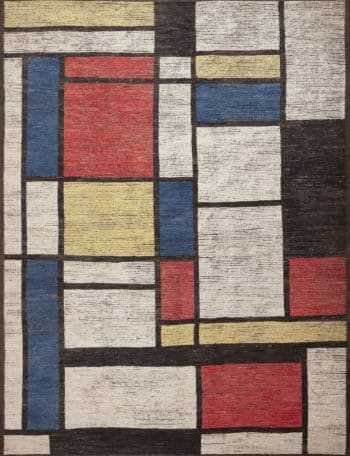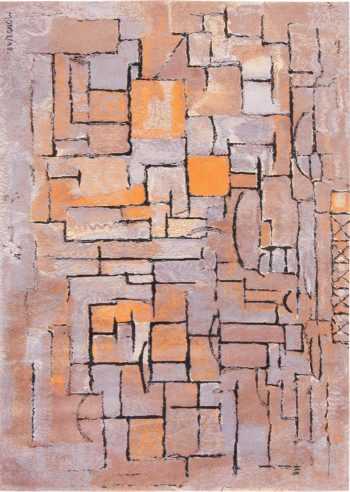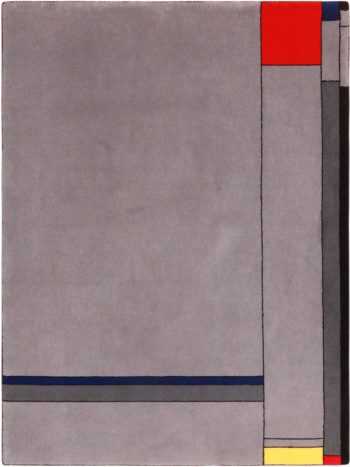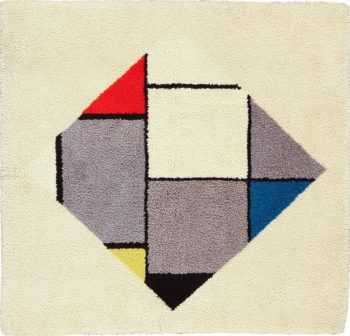Piet Mondrian Rugs
View our current collection of artistic vintage rugs by the iconic artist Piet Mondrian:
Contemporary Artistic Piet Mondrian Inspired Modern Art Area Rug 11613
$8,813.00Size: 10 ft 8 in x 14 ft (3.25 m x 4.27 m)Artistic Modern Contemporary Piet Mondrian Design Room Size Area Rug 11457
$6,930.00Size: 9 ft 5 in x 12 ft 5 in (2.87 m x 3.78 m)Scandinavian Rug after Piet Mondrian 47630
$18,500.00Size: 8 ft x 11 ft (2.44 m x 3.35 m)Vintage Scandinavian Mondrian Design Rug 72315
$4,400.00Size: 4 ft 11 in x 6 ft 7 in (1.5 m x 2.01 m)Square Vintage Modernist Scandinavian Mondrian Design Rug 49524
$3,900.00Size: 5 ft 2 in x 5 ft 2 in (1.57 m x 1.57 m)
Learn More About Artistic Rugs By Artist Piet Mondrian
Dutch painter Piet Mondrian gained his notoriety for carving his own unique and innovative niche in the global world of art, and is considered by many one of the greatest painters of the 20th century. He’s perhaps best known for being one of the pioneer painter founders of an art movement called De Stijl, or Neoplasticism, which involved purist abstraction and reducing art to its form and color essentials.
De Stijl was a novel art form for the early 20th century that basically simplified visual composition to horizontal and vertical perceptions while only using primary, black, and white colors. Part of the movement was also based on reductive theory, which brought large scale images to life on a smaller scale on canvas, in architecture, and through graphic arts.
Who Was Piet Mondrian?
Mondrian was born March 7, 1872 in Amersfoort, Netherlands. He attended the Rijksadame van Beeldende in Amsterdam for his formal training. His interpretations as an artist would go through profound and trail-blazing changes throughout his life, and he would become an enormous influencer of abstract painting, design, architecture, and even fashion. Today, modernism can hardly be said without the mention of Mondrian’s name.
Despite being born over 20 years after Vincent Van Gogh, the world of art had seen relatively little change from when Van Gough entered the marshes to paint. Mondrian’s early art works and style mimicked such impressionist techniques and forms. His initial career largely used a pointillism and Fauvism style of expressive stroke and inclusion of glowing, pure colors for landscape design, still images, and other scenes.
It would be the first decade of the 20th century before Mondrian’s career would begin to move toward a cubist, pointillist, and abstract medium style.

Artist Piet Mondrian
Dutch artists were becoming more and more familiar with Paul Cezanne and the much more radical works of such Cubist painters. Mondrian’s place in avant-garde circles ensured he was influenced by the new Paris art movement. In fact, to better integrate himself in the Parisian avant-garde, he removed an “a” from the original Dutch spelling of his name – “Mondriaan.”
Piet Mondrian was immediately taken aback and impressed when he saw the Cubist works of Pablo Picasso in 1911, and thus began his own adaptation of Cubism for his original works. It was the start of career that would become legendary.
In the winter of 1911 and 1912, Piet Mondrian did two versions of Still Life with Gingerpot. The first version was a recognizable rendition of forms found in everyday life, but the second version featured those same objects as compositional structures. It proved to be a moment of transition and drive toward abstraction for his career.
By the summer of 1914, Piet Mondrian would leave Paris to travel back to the Netherlands to attend to his ailing father. The first World War would erupt and prevent him from immediately returning to Paris.
Stuck in Holland, Mondrian’s art would make yet another transition in the abstract art form, which would later be labeled as a neoplastic style. His works featured balanced composition forms and use of lighter and simplified colors than it had previously. There was also a movement toward works that depicted a connection with religion, faith, and a spiritual realm, which was a relationship and focal point Mondrian’s work had never shown before.
As the war came to a close, Mondrian decided to return to Paris. In 1917, he met his fellow co-founders of the De Stijl moment, including Theo van Doesburg. These talented artists formed a group that would immortalize their names in the history of art.
The De Stijl movement wasn’t just an extension of art form or theory onto canvas. It’s aesthetic principles and members transcended to architecture, sculpture, graphic art, and even fashion. The group’s abstract concept of art flourished within the intellectual freedoms of Paris’s post-war culture.
The relationship between Mondrian and van Doesburg would eventually fracture, however. The two had a serious disagreement over the usage of diagonal painting and artwork lines, and Mondrian left the group over it.
He began to explore new movements and create works apart from the group’s former confines. In 1931, he became part of a pure abstraction association of painters and sculptors called the Abstraction-Creation. Within this group, his career flourished in an environment more open to different and new styles of creativity.
Mondrian’s minimalist style would truly peak in the 1930’s, and thinner and doubled lines became the precedence in his paintings. In honor of his 60th birthday, The Stedelijk Museum held an exhibit of his work in 1932.
Some art historians purport that the 1930’s was perhaps Mondrian’s period of most significant artistic development. Indeed, he became fascinated with lines, dismantling the defining moments of a painting, and dissecting the very definition of painting in of itself.
According to Mondrian, the line exemplifies drawing and draftsmanship, and both have always been at the heart of painting throughout every major art moment in history; he contended that no one had ever challenged that thought before.
In 1938, under threat by the Second World War and invading fascism, Mondrian fled for London. By 1940, Paris had fallen, and Mondrian decided to leave London for the USA. He would remain in Manhattan, New York until his death in 1944.
Mondrian’s first ever solo exhibit was in 1942 at a grand Manhattan NYC gallery. It was something his art peers, fans, and spectators alike marveled in seeing.
His talents reached beyond the expression of paint to canvas and creation of art groups, reforms, and movements. Mondrian was also a talented writer, many of which pieces were theoretical texts published by magazines and other media sources. The majority of his writing concerned neoplasticism and abstract art work as a general label.
This leader of progressive styles and forms remains a renowned figure around the globe, and his art remains housed and on exhibit by some of the most famous galleries in the world, including those in New York, Paris, Amsterdam, Switzerland, and the National Gallery of Art in Washington, D.C..
He was known to work long hours to the point of physical exhaustion and blistered hands. With work that bled into the hearts of masses over decades and his appeal as a reformist, Mondrian is one of the most well known and beloved artists of the 20th century.
Again, his art is something that’s transcendent of the painting and sculpture world, too. Fashion designer Yves Saint Laurent’s Fall 1965 Mondrian collection is a prime example. The line of shift dresses, coats, and boats featured primary color with black bordering that was largely inspired by Mondrian’s art. It’s a testament to the reach of his work.
Broadway Boogie Woogie, a 1942-43 Mondrian painting that makes use of brightly colored shimmering squares, at Manhattan’s Museum of Modern Art remains a highly influential piece in abstract geometric painting. It and it’s unfinished counterpart, Victory Boogie Woogie, are bright, lively, and almost musical reflections of how the artist’s short time in New York perhaps inspired the start of yet another revolutionary and profound change in Mondrian’s career. Sadly, his death leaves the world to wonder the potential for what could’ve been.
The Paris Studio of Mondrian is simply iconic and has served as inspiration for many abstract artists. Harry Holtzman and Fritz Glarner, friends of Mondrian, carefully filmed and photographed Mondrian’s New York studio. Every inch of the wall compositions were carefully traced and documented. The studio was then opened for a six-week exhibition before being dismantled. The tracings were later used to create portable Mondrian compositions, which have seen been titled as “The Wall Works” and have been exhibited in Manhattan, SoHo, Japan, Sao Paulo, Michigan, Berlin, and elsewhere.
Perhaps one of the most beloved Mondrian works is housed by the Tate Gallery in London. It’s a piece that’s foretelling in the color experimentation that would be a major asset to his works toward the end of his life. Composition with Yellow, Blue, and Red is a piece that was an obvious fresh take on abstract art for its time and continues to make an impact with modern artists today. The list of Mondrian contributions that have and continue to make a lasting impact on the world of art is as mesmerizing as his work itself.





